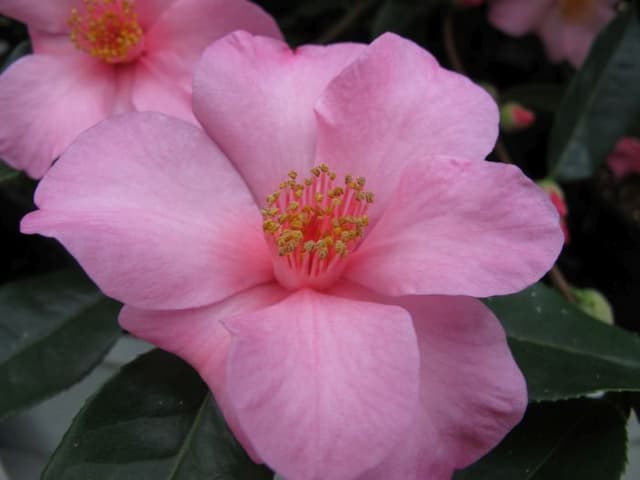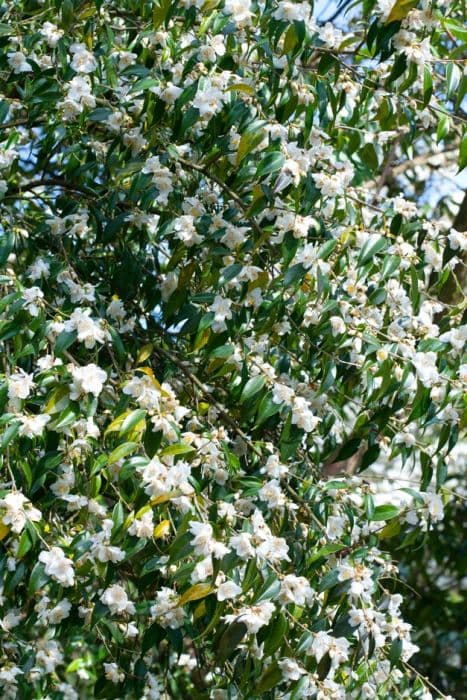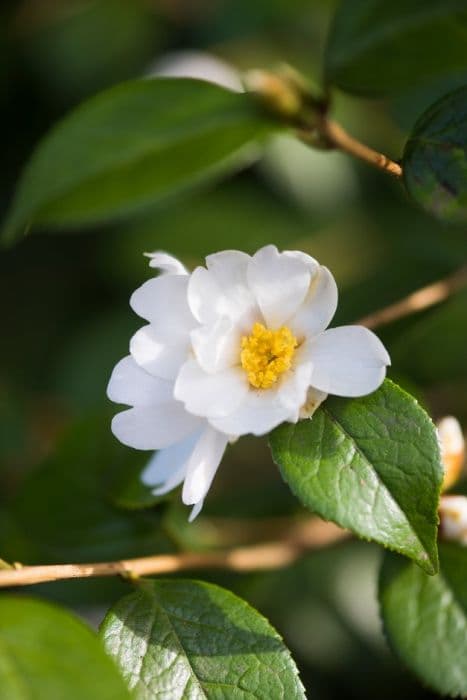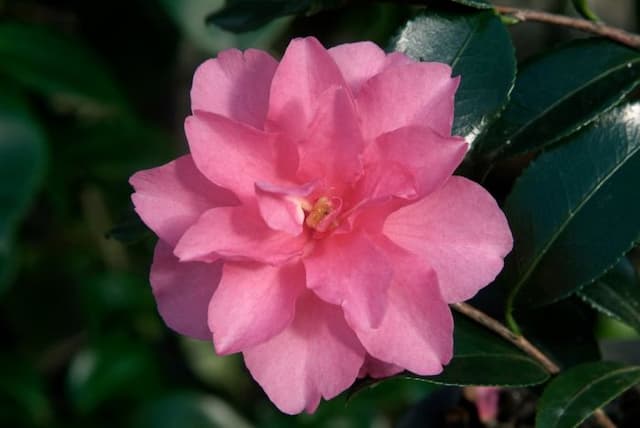Japanese Camellia Camellia japonica 'Guilio Nuccio'

ABOUT
The Camellia japonica 'Guilio Nuccio' — often referred to simply as the Camellia — is a notable plant esteemed for its stunning floral display and striking foliage. The plant typically flourishes with lustrous, evergreen leaves that present a deep green hue and have an oval to elliptical shape. The texture of the leaves is leathery with a slightly serrated edge, which adds a tactile dimension to the plant's appearance. The most captivating aspect of the Camellia 'Guilio Nuccio' is its large, showy flowers, which showcase an alluring complexity. These blooms possess a rich, velvety texture and generally form a peony-like shape with elegantly ruffled petals that can range in color from deep pink to red. At the heart of each blossom, a cluster of bright yellow stamens often contrasts vividly with the petals, creating an eye-catching focal point. Camellia flowers are known for their symmetrical appearance and can boast an impressive size, adding to their ornamental value. The blossoms make a dramatic statement in any garden space where they're grown, catching the eye of onlookers and often becoming the centerpiece in garden designs during their blooming season. With their combination of luxurious foliage and spectacular flowers, Camellias like the 'Guilio Nuccio' contribute both color and texture to landscapes, creating a romantic and somewhat exotic ambience.
About this plant
 Names
NamesFamily
Theaceae.
Synonyms
Japanese Camellia, Common Camellia, Rose of Winter.
Common names
Camellia japonica 'Giulio Nuccio'.
 Characteristics
CharacteristicsLife cycle
Perennials
Foliage type
Evergreen
Color of leaves
Green
Flower color
Red
Height
6-10 feet (1.8-3 meters)
Spread
6-10 feet (1.8-3 meters)
Plant type
Shrub
Hardiness zones
7
Native area
Japan
Benefits
 General Benefits
General Benefits- Aesthetic Appeal - Camellia japonica 'Guilio Nuccio' has vibrant, showy flowers that enhance the visual beauty of gardens and landscapes.
- Year-round Interest - The evergreen foliage provides a constant green backdrop throughout the year, while the blooms add seasonal interest in late winter to spring.
- Wildlife Attraction - The flowers can attract pollinators such as bees, providing a natural support system for local ecosystems.
- Low Maintenance - Once established, they are relatively low maintenance, requiring minimal care beyond occasional pruning and fertilizing.
- Versatility - They can be used in a variety of landscape designs, including as specimen plants, hedges, or even container plants.
- Drought Resistance - Although they prefer moist soil, established plants have moderate drought tolerance.
- Shade Tolerance - Camellia japonica can thrive in partial shade, making them suitable for understory planting or north-facing gardens.
 Medical Properties
Medical PropertiesThis plant is not used for medical purposes.
 Air-purifying Qualities
Air-purifying QualitiesThis plant is not specifically known for air purifying qualities.
 Other Uses
Other Uses- Culinary garnish: The vibrant petals of the Camellia japonica 'Guilio Nuccio' can be used to add a splash of color to salads and desserts, provided they have been grown without the use of pesticides.
- Fabric dye: The petals can be boiled to extract natural dyes for coloring fabrics with soft pinks and reds, offering an eco-friendly dyeing option.
- Art supplies: The plant's petals can be crushed to create natural pigments for eco-friendly paints and inks used by artists.
- Photography: With their bold colors and large blossoms, these flowers make excellent subjects for botanical photography and can be used in educational materials to teach about plant morphology.
- Wedding decorations: The vibrant blooms can be used in bridal bouquets or as part of the floral arrangements at wedding ceremonies, adding natural elegance to the venue.
- Craft projects: Dried petals and leaves can be a component in homemade potpourri or used for crafting, such as in making handmade paper or bookmarks.
- Religious ceremonies: In some cultures, the flowers may be used as offerings or decorations in various spiritual and religious ceremonies, symbolizing different aspects such as longevity or seasonal change.
- Education and research: While not unusual, these plants can serve as a tool in educational settings, like botanical gardens and horticulture programs, to teach about plant care and breeding.
- Instrument construction: In some instances, the dense wood of the Camellia japonica 'Guilio Nuccio' can be employed in the crafting of certain musical instrument parts.
- Perfumery: Selective breeding and processing of the petals could be explored to create natural fragrances or to serve as inspiration for the development of perfumes, capturing the essence of the flower's scent.
Interesting Facts
 Feng Shui
Feng ShuiThe Camellia is not used in Feng Shui practice.
 Zodiac Sign Compitability
Zodiac Sign CompitabilityThe Camellia is not used in astrology practice.
 Plant Symbolism
Plant Symbolism- Admiration: The Camellia japonica often represents deep respect and admiration, making it a perfect gift to someone whom you hold in high esteem.
- Perfection: With its perfect symmetry and beauty, the Camellia is also a symbol for the ideal or perfect. It can suggest flawless beauty or something to aspire to.
- Love: Different colors of Camellias symbolize various aspects of love. Generally, the Camellia, especially the red one, signifies love, affection, and devotion.
- Longevity: Camellias are known for their long-lasting blooms and evergreen quality, symbolizing longevity and the enduring nature of life.
- Gratitude: Giving someone a Camellia is a way of showing gratitude; it's a polite, subtle way of saying "thank you."
 Water
WaterThe Camellia, specifically the 'Guilio Nuccio' variety, thrives with consistent moisture but dislikes waterlogged soil, so ensure the planting medium is well-draining. Water the plant thoroughly when the top inch of the soil feels dry to the touch, which typically means once a week, but this may vary with climate and weather conditions. During the growing season, in spring and summer, it may require more frequent watering, perhaps twice a week, especially in dry spells. However, reduce watering in the fall and further in winter when the plant is dormant. A rough guide is to provide about 1-2 gallons per watering session for an established shrub, ensuring even soil moisture without over-saturation.
 Light
LightCamellias, including 'Guilio Nuccio', do best in partial shade or dappled sunlight. An ideal spot would be under the high, open branches of tall trees which provide filtered light. Too much direct sunlight can lead to leaf scorch, while too little can affect blooming. East or west-facing gardens that offer morning or late afternoon sun with protection from the harsh midday rays are excellent choices for these plants.
 Temperature
TemperatureCamellias, like the 'Guilio Nuccio', prefer moderate temperatures and are generally hardy in USDA zones 7-9. They can withstand occasional dips in temperature down to 20 degrees Fahrenheit but thrive best when temperatures range between 50 and 80 degrees Fahrenheit. Prolonged exposure to temperatures below 20 degrees or above 90 degrees may cause damage to the plant.
 Pruning
PruningPrune Camellias, including 'Guilio Nuccio', to maintain shape and remove any dead or weak wood. Pruning is best done after flowering has ceased in spring since Camellias set their flower buds in the summer for the following season. Light pruning each year or so helps to keep the plant healthy and encourages more prolific blooming. Remember to use clean, sharp tools to make clean cuts and minimize stress to the plant.
 Cleaning
CleaningAs needed
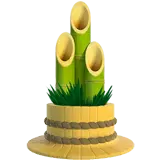 Soil
SoilThe Japanese Camellia 'Guilio Nuccio' thrives best in well-draining, acidic soil with a pH between 5.5 and 6.5. A blend consisting of 2 parts peat, 1 part perlite, and 1 part organic compost or pine bark would provide an ideal growing medium.
 Repotting
RepottingJapanese Camellias like 'Guilio Nuccio' generally require repotting every 2-3 years. They should be repotted in the spring before the onset of new growth.
 Humidity & Misting
Humidity & MistingJapanese Camellia 'Guilio Nuccio' prefers a moderate to high humidity level, ideally between 40-50%. Avoid placing the plant in extremely dry environments.
 Suitable locations
Suitable locationsIndoor
Place in bright, indirect light; ensure good air flow.
Outdoor
Plant in dappled shade, protect from afternoon sun.
Hardiness zone
7-9 USDA
 Life cycle
Life cycleCamellia japonica 'Guilio Nuccio', commonly known as the 'Guilio Nuccio' camellia, begins its life cycle as a seed, which germinates in moist, well-drained soil in a shaded environment. Upon germination, the seedling emerges, developing a taproot and foliage as it matures into a young plant. With time, the young camellia grows into a bushy evergreen shrub, which can take several years to reach its full mature size, displaying glossy, dark green leaves. In the early spring, the camellia plant reaches the flowering stage, producing large, showy blooms that are typically a deep pink to red color. After pollination, which is often assisted by insects, the flowers are followed by the development of dry capsules, which upon maturing, split open to release seeds for reproduction. Throughout its life, the 'Guilio Nuccio' camellia requires pruning and care to sustain health and promote the annual cycle of new growth and blooming.
 Propogation
PropogationPropogation time
Spring-Early Summer
Propogation: Camellia japonica 'Guilio Nuccio', commonly known as the Japanese Camellia, is typically propagated through semi-hardwood cuttings taken in late summer to early fall. The cutting should be about 4 to 6 inches (10 to 15 cm) long and contain several leaf nodes. The lower leaves are removed and the cut end is dipped in rooting hormone to stimulate root development. The cutting is then placed in a well-draining soil mixture, ensuring that a few leaf nodes are below the surface for root growth. High humidity and consistent moisture are maintained to encourage rooting, often by covering the cutting with a plastic bag or using a propagation mist system. The cuttings require a warm environment, ideally between 70 and 75 degrees Fahrenheit (21 to 24 degrees Celsius), and should root within 6 to 8 weeks.
